Near-infrared (NIR) waves boost blood vessel performance mainly by increasing nitric oxide production, which relaxes vascular smooth muscle. This leads to vasodilation, improving blood circulation and reducing resistance in blood vessels. NIR therapy activates key molecular pathways, enhancing endothelial function and promoting better blood pressure regulation. You'll notice immediate benefits, too, as NIR exposure can greatly raise blood flow velocity almost instantly. Regular sessions can lead to long-term improvements, making it a promising option for cardiovascular health. If you're curious about the broader applications and future possibilities of NIR waves, there's much more to discover.
Understanding Near-Infrared Waves
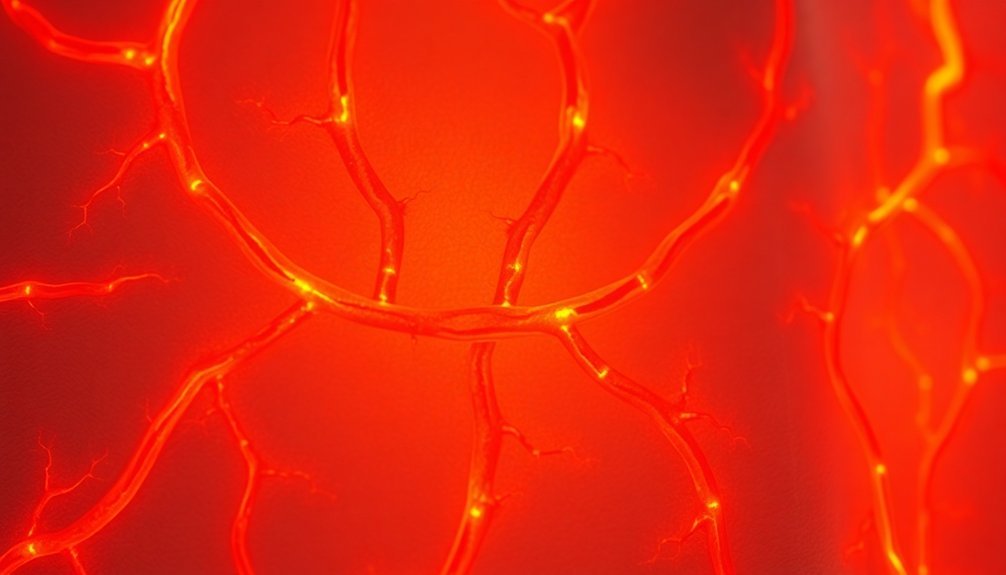
Near-infrared waves, found just beyond the visible light spectrum, range from about 700 to 2500 nanometers. Although you can't see these wavelengths, they're an essential part of the electromagnetic spectrum. They're safe for both your eyes and body, making them suitable for various applications, especially in medical settings.
Near-infrared light plays a pivotal role in diagnostics, as it penetrates biological tissues effectively without requiring extensive sample preparation.
One of the standout applications of near-infrared waves is near-infrared spectroscopy (NIRS). You'll find this technology in areas like blood sugar monitoring and pulse oximetry, where it helps assess the levels of oxygen in your blood. It also shows up in functional neuroimaging, enhancing our understanding of tissue oxygenation and metabolism. In addition, the ability of near-infrared light to penetrate cloud cover makes it invaluable for remote sensing applications.
Thanks to its penetrating ability, near-infrared light can reach deep into the scalp and skull, stimulating beneficial biochemical responses. This interaction promotes energy production in mitochondria, vital for maintaining healthy cell function.
As you explore the benefits of near-infrared waves, you'll see how they serve not just for diagnostics but also for enhancing overall health and well-being.
Mechanisms of Vasodilation
Understanding how near-infrared waves influence blood vessel performance brings us to the mechanisms of vasodilation. Several metabolic factors play essential roles, like adenosine formation, which increases during low oxygen and prompts vasodilation. The release of ATP during muscle contractions and by red blood cells also triggers this process by activating purinergic receptors that stimulate nitric oxide production.
Additional factors, such as increased carbon dioxide and hydrogen ion levels, further promote vasodilation, especially in the brain. Active hyperemia occurs when heightened tissue metabolism demands increased blood flow, illustrating the interconnectedness of these mechanisms.
On an intracellular level, mechanisms involving ion channels are significant. For instance, the activation of ATP-sensitive potassium channels leads to potassium efflux and smooth muscle relaxation. Calcium channel inhibition, particularly of L-type calcium channels, reduces calcium influx, facilitating vasodilation.
Additionally, enhancing the cGMP pathway decreases intracellular calcium, which is key for relaxing smooth muscle. Lastly, myosin light-chain dephosphorylation contributes to this relaxation, allowing blood vessels to widen.
These combined metabolic and intracellular mechanisms help explain how your body regulates blood flow, ensuring ideal performance and function during various activities and conditions.
Enhancing Endothelial Function
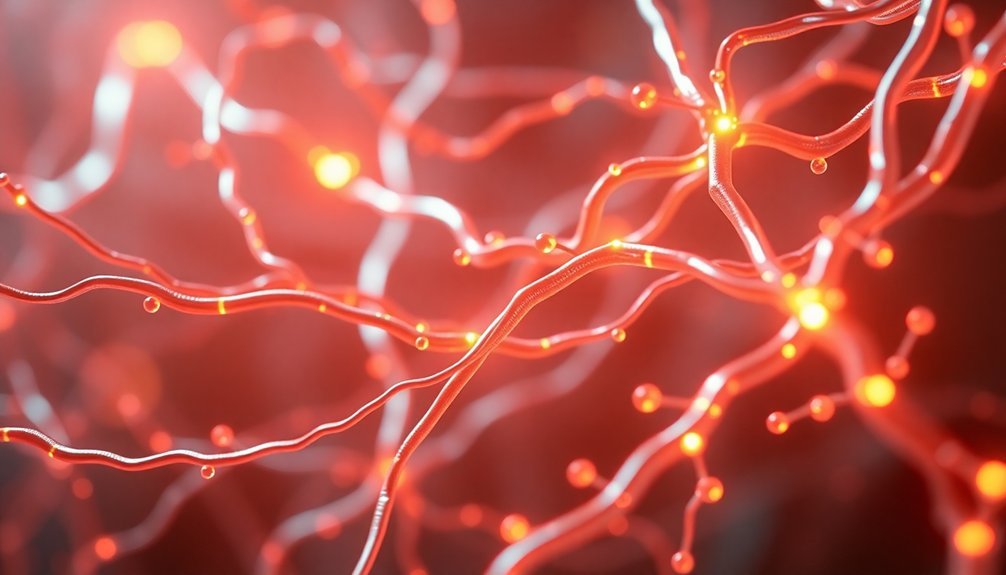
Near-infrared therapy is essential for enhancing endothelial function through improved nitric oxide production. By increasing NO levels, you'll notice better blood pressure regulation and smoother blood flow. This not only supports cardiovascular health but also reduces the risk of vascular issues. Additionally, a healthy lifestyle that includes regular exercise can further contribute to enhanced endothelial function and amplify the benefits of nitric oxide.
Improved Nitric Oxide Production
Improved nitric oxide production plays an essential role in enhancing endothelial function, which is fundamental for maintaining vascular health. Near-infrared II (NIR-II) laser irradiation at specific wavelengths, like 1064 and 1270 nm, effectively boosts nitric oxide (NO) release from endothelial cells. This process hinges on increasing the phosphorylation of endothelial nitric oxide synthase (eNOS) at Ser 1177, activated by Akt signaling linked to mitochondrial retrograde signaling.
To produce NO, eNOS requires L-arginine, oxygen, calcium-calmodulin, and other cofactors, resulting in citrulline as a byproduct. As a powerful vasodilator, NO relaxes blood vessels, consequently lowering blood pressure. It inhibits vascular smooth muscle contraction, platelet aggregation, and leukocyte adhesion to the endothelium. These actions are crucial for regulating blood flow and maintaining blood pressure.
Utilizing NIR-II laser technology presents promising therapeutic implications. It may serve to restore endothelial NO levels, helping to prevent or treat cardiovascular diseases.
Additionally, red light therapy at 670 nm can also stimulate NO production, enhancing blood flow. Both NIR and red light therapies showcase potential for individuals battling impaired blood flow, making them critical tools for vascular health.
Enhanced Blood Pressure Regulation
Enhanced blood pressure regulation hinges on the ideal function of endothelial cells, which are essential in maintaining vascular health. These cells can be notably influenced by the application of near-infrared waves. The interaction of this light with mitochondria enhances several cellular functions that promote better blood pressure regulation.
Here's how this occurs:
- Modulation of endothelial dysfunction by increasing oxygen consumption and ATP production.
- Improved angiogenesis, leading to the formation of new blood vessels and reduced risk of vascular diseases.
- Enhanced vasodilation, contributing to better regulation of arterial tone and blood flow.
- Minimized inflammation through photobiomodulation, which supports hypertension treatment.
Impact on Blood Pressure
The therapeutic benefits of infrared light therapy on blood pressure are becoming increasingly evident. When you use infrared light therapy, it causes your blood vessels to dilate, which directly improves circulation. This dilation reduces the lining volume within the vessels, leading to healthier blood pressure levels.
As the internal diameter increases, vascular resistance decreases, enhancing blood flow notably. This effect is especially beneficial for individuals dealing with endothelial dysfunction or other blood vessel issues.
Additionally, infrared radiation helps drive blood flow independently from heart activity. Studies indicate that it can increase venous blood flow velocity by about 30%, even when the heart isn't pumping. This mechanism showcases its potential to aid circulation thoroughly.
Regular sessions of infrared light therapy can lead to noticeable reductions in both systolic and diastolic blood pressure. For example, a study from the University of Missouri Kansas City reported notable blood pressure declines through consistent 30-minute therapy sessions.
This therapy not only improves cardiovascular function but also reduces the risks of heart disease and stroke. Incorporating infrared light therapy into your routine can have a considerable impact on managing blood pressure and enhancing overall health.
Promoting Nitric Oxide Production
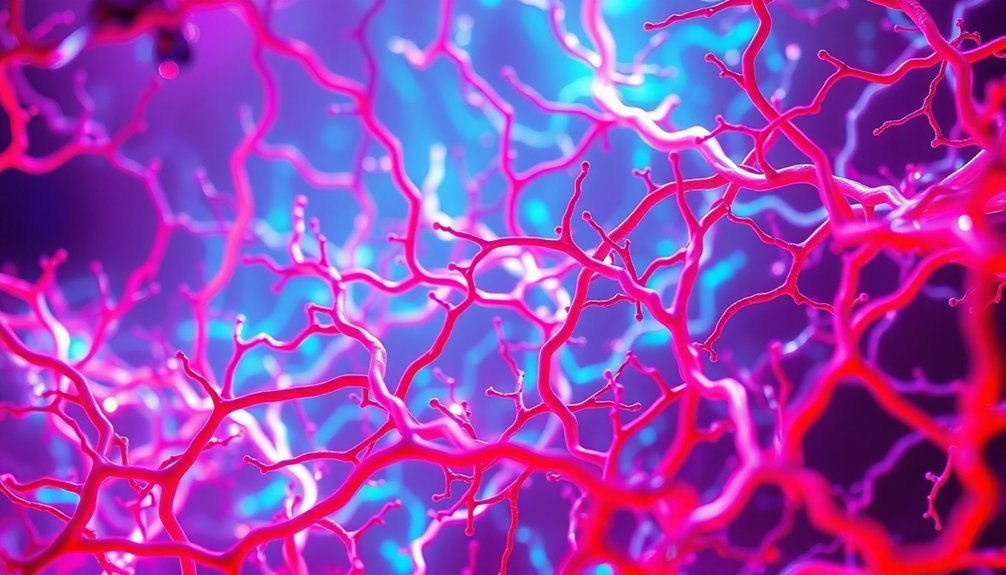
Blood vessel performance can greatly benefit from increased nitric oxide (NO) production, which plays an essential role in vascular health. Near-infrared (NIR) light, especially at specific wavelengths like 808 nm and 1064 nm, activates endothelial nitric oxide synthase (eNOS) to produce NO from L-arginine. This process is vital for maintaining proper blood flow and pressure.
Here's how NIR light enhances NO production:
- Akt and eNOS Activation: NIR exposure triggers the phosphorylation of both Akt and eNOS, pivotal steps in the signaling pathway for NO production.
- Vasodilation: The resultant increase in NO leads to the relaxation of vascular smooth muscle, enhancing blood flow.
- Rapid Effects: Clinical trials have shown significant peaks in NO levels shortly after NIR treatments, demonstrating its immediate benefit.
- Therapeutic Potential: Enhanced NO production can be essential for conditions requiring improved blood flow, like diabetes and hypertension.
Reducing Oxidative Damage
Reducing oxidative damage is essential for your cells and tissues, as it helps maintain their health and functionality.
By using near-infrared (NIR) therapy, you can enhance mitochondrial performance and activate antioxidant enzymes, which work together to lower oxidative stress.
This approach not only improves cellular energy but also fortifies your body's defenses against harmful free radicals.
Mechanism of Oxidative Stress
In the domain of vascular health, understanding the mechanisms behind oxidative stress is essential for developing effective strategies to mitigate its damaging effects. Oxidative stress arises when reactive oxygen species (ROS) overwhelm the body's antioxidant defenses. This phenomenon can damage cells in the vascular system, particularly affecting endothelial function.
Key aspects of oxidative stress include:
- Sources of ROS: NAD(P)H oxidase in vascular cells, angiotensin II stimulation, and oxidation of LDL by endothelial and smooth muscle cells.
- Effects on Endothelial Dysfunction: Increased adhesion molecules and constrictor agents impair the endothelium's ability to regulate blood flow.
- Formation of Foam Cells: Oxidized LDL triggers inflammatory responses, leading to foam cell formation, which contributes to atherosclerosis.
- Inflammatory Response: Hypertension activates inflammation, further exacerbating oxidative stress and endothelial dysfunction.
These processes collectively lead to vascular dysfunction, characterized by altered tone regulation and increased cell adhesion.
Recognizing these mechanisms can guide future therapeutic strategies to reduce oxidative stress, enhance blood vessel performance, and improve overall vascular health.
Benefits of Reduced Oxidation
Oxidative stress has profound effects on vascular health, leading to inflammation and dysfunction that can hinder blood flow. By reducing oxidative stress, you can effectively decrease vascular inflammation, minimizing the production of proinflammatory cytokines that restrict circulation.
This reduction also lowers the formation of oxidized LDL (ox-LDL), a significant contributor to vascular inflammation. With less inflammation, your blood vessels function better, enhancing overall circulation and helping conditions like arthritis and chronic pain.
Moreover, protecting blood vessel integrity is essential. Oxidative stress can damage blood vessel walls, resulting in endothelial dysfunction.
Antioxidants, like curcumin, play a significant role.
NIR Therapy Impact
How can near-infrared (NIR) therapy greatly impact oxidative damage in blood vessels? By enhancing mitochondrial function and boosting ATP production, NIR therapy stands out as a significant player in reducing oxidative stress. It manages oxidative stress levels, preventing the accumulation of harmful reactive oxygen species (ROS) and protecting cells from oxidative damage.
Here are some key mechanisms through which NIR therapy works:
- Increases mitochondrial efficiency, leading to improved cellular energy.
- Reduces pro-inflammatory cytokines, thereby cutting down chronic inflammation.
- Stimulates vasodilation, enhancing blood flow and reducing stress-related constriction.
- Inhibits enzymes like COX-2, which contribute to inflammatory pathways.
These actions help preserve cellular function and promote blood vessel health, making NIR therapy a crucial resource for addressing oxidative damage.
With its ability to enhance immune responses and support new blood vessel formation, NIR therapy not only mitigates oxidative stress but also fosters a healthier vascular system overall. Your blood vessels stand to gain immensely from this innovative therapy, paving the way for improved functionality and longevity.
Improving Blood Flow Dynamics
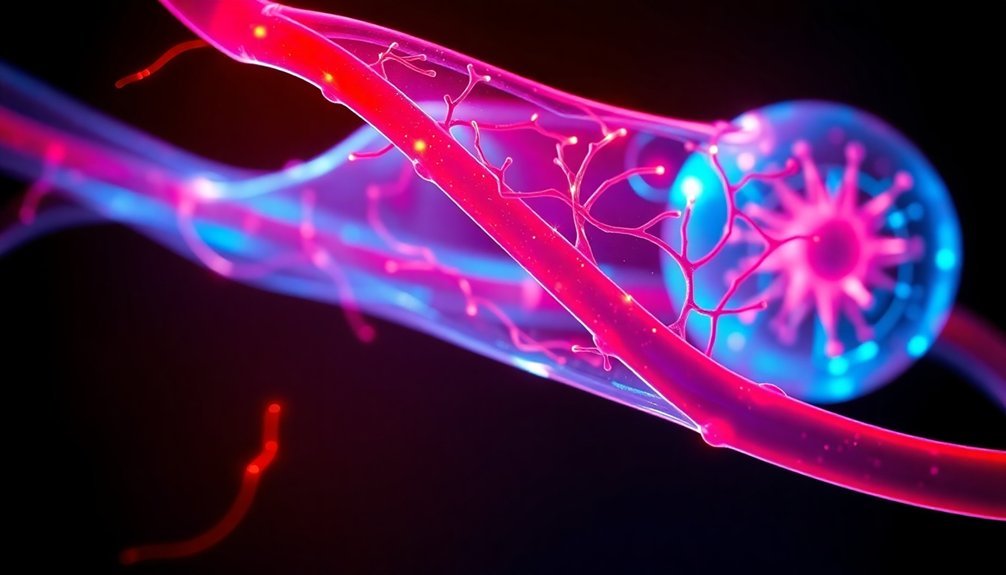
Researchers have uncovered a promising way to enhance blood flow dynamics using near-infrared (IR) waves. This technique fuels blood flow in both postmortem and physiological states by leveraging a surface-induced flow mechanism that operates independently of cardiac pressure.
The unique interactions at the vascular surface generate chemical concentration gradients, resulting in a remarkable increase in blood flow velocity. In postmortem conditions, IR exposure can ramp up blood flow velocity by more than 300%, while in physiological conditions, you can expect a boost of around 30%.
As you explore deeper into this phenomenon, you'll notice that IR application initiates this increased flow almost immediately, with notable changes measured through particle-image velocimetry.
What's intriguing is that when the IR source is removed, the flow velocity typically drops back to baseline levels. Additionally, IR exposure may elevate heart rate, suggesting a link to biochemical events driven by temperature changes.
This interrelation highlights the complexity of how IR impacts both the heart and the vascular system. Overall, these findings could pave the way for therapeutic strategies to improve circulation, particularly in individuals with compromised cardiac function.
Applications in Vein Visualization
Near-infrared (NIR) technology transforms the way clinicians visualize superficial veins, making procedures like IV placement quicker and more efficient.
By utilizing this cutting-edge technology, you'll see veins, valves, and bifurcations that aren't visible to the naked eye. This enhanced visualization aids in ideal peripheral venous access, especially in challenging cases.
Here are some key benefits of NIR in vein visualization:
- Effective for All Skin Tones: Adjustability in brightness means it works well in various light conditions and for all skin tones.
- Improved First-Time Insertion Success: The first-time insertion success rate can reach up to 73% due to enhanced visibility.
- Real-Time Imaging: Immediate imaging allows for adjustments on the fly during procedures.
- Pediatric Focus: NIR significantly reduces the failure rate in blood withdrawals in pediatric patients from 13% to just 2%.
With its lightweight design and high-speed laser technology, NIR not only streamlines venipuncture but also enhances clinical practice, making your job easier and improving patient outcomes.
NIR Therapy and Cognitive Health

NIR therapy isn't just about visualizing blood vessels; it's also making waves in cognitive health.
By enhancing cognitive function and reducing oxidative damage, you're not just improving your brain's performance, but also protecting it from stress and degeneration.
This approach offers promising benefits, especially for those dealing with neurodegenerative conditions.
Enhanced Cognitive Function
Enhanced cognitive function can be considerably influenced by near-infrared therapy, which promotes improved cerebral blood flow and oxygen delivery to brain cells.
This increase in blood flow enhances overall brain performance, particularly in individuals with traumatic brain injuries (TBI). By using near-infrared light, you may notice improvements in various cognitive areas, as it boosts oxygen consumption in the frontal cortex and stimulates the release of nitric oxide.
Here are a few key benefits of near-infrared therapy for cognitive health:
- Enhances executive function and verbal memory in TBI patients.
- Increases Delta, Theta, and Alpha brainwaves, promoting higher cognitive levels.
- Improves skills in organization, prioritization, and emotional regulation.
- Reduces PTSD symptoms and enhances sleep patterns, facilitating better overall mental health.
Reduced Oxidative Damage
Oxidative damage poses a significant threat to cognitive health, particularly after traumatic injuries. Near-infrared (NIR) light therapy, especially at 670 nm, effectively reduces oxidative stress in areas susceptible to secondary degeneration.
When you expose these vulnerable regions to NIR light, it helps mitigate the spread of oxidative stress through the optic nerve via astrocytes. You'll notice a significant decrease in harmful reactive oxygen species (ROS) like superoxide and hydrogen peroxide, bringing their levels close to background levels within just a few days.
This drop in ROS correlates directly with improved mitochondrial function, respiration, and ATP synthesis, essential for healthy cellular operations.
Furthermore, NIR light protects against cellular debris accumulation and inflammatory markers, helping maintain cellular homeostasis. It stimulates the brain's glymphatic system flow, promoting the clearance of excess metabolites and protein aggregates linked to cognitive decline.
Technological Advancements in Imaging
Revolutionizing how we visualize blood vessels, recent technological advancements in imaging harness the unique properties of near-infrared waves. With near-infrared waves causing less absorption and scattering in tissues, you can now see subsurface blood vessels more clearly than ever before.
Ideal wavelengths like 585nm to 670nm, and especially around 850nm, provide high luminous intensity for effective vein imaging.
Here are some key advancements in this field:
- Near Infrared-2 Imaging (NIR-2): This technique utilizes water-soluble carbon nanotubes for real-time visualization of blood flow.
- Specialized Sensors: Cameras like the NoIR by Adafruit enhance image quality considerably compared to standard cameras.
- Image Processing Techniques: Denoising methods and algorithms like Hessian ridge detection help improve clarity and detail in vascular imaging.
- Flexible Wavelength Use: Different wavelengths can be selected based on application needs, allowing for varied depths and clarity for the blood vessel images.
Together, these advancements not only enhance visual clarity but also pave the way for improved research into blood vessel dynamics and pathology.
Clinical Implications and Benefits
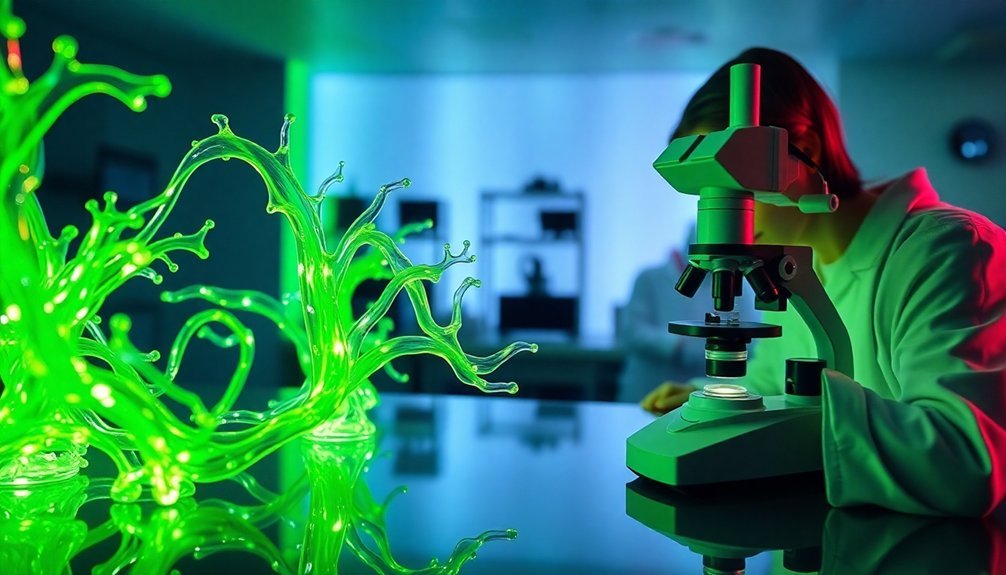
Near-infrared (NIR) technology is transforming clinical practices across various medical fields, particularly in vascular surgery and patient care. By utilizing near-infrared spectroscopy (NIRS), you're able to assess tissue oxygenation in real-time during complex surgeries like thoraco-abdominal aortic aneurysm (TAAA) procedures. This immediate feedback enables you to make vital adjustments, which can greatly improve patient outcomes and reduce the risk of paraplegia post-operation.
Moreover, NIR light promotes vasodilation through increased nitric oxide production, enhancing blood flow and markedly aiding vascular function. When you stimulate vascular endothelial growth factor (VEGF), it encourages angiogenesis, which can help lower the workload on the heart and manage hypertension more effectively.
In addition, NIR therapy shows promise for cognitive benefits by enhancing cerebral blood flow, which is particularly beneficial in patients recovering from traumatic brain injuries. It effectively improves cognitive functions, helping with memory and executive tasks while minimizing oxidative damage.
Lastly, NIR technology assists in inflammation reduction by modulating the immune response, providing further support in managing various inflammatory conditions.
These advancements already demonstrate a profound positive impact on clinical practices, enhancing overall patient care.
Future Directions in NIR Research
Exciting possibilities lie ahead in the domain of NIR research, as advancements in technologies and methodologies continue to evolve.
With innovations in wearable neuroimaging, enhanced blood flow mechanisms, and emerging spectroscopic imaging techniques, we recognize we're on the brink of substantial breakthroughs.
Here are some key future directions you might find intriguing:
- Wearable High-Density fNIRS: Progress in wireless systems will allow for unobtrusive monitoring of brain activity in diverse settings, enhancing ecological validity.
- Multimodal Approaches: Combining fNIRS with other modalities opens up possibilities for studying complex neurodegenerative diseases and pediatric conditions.
- Improved Imaging Techniques: NIR-II spectroscopy promises superior tissue penetration and spatial resolution, enabling real-time blood flow velocity tracking.
- Machine Learning Integration: Utilizing machine learning can refine NIRS applications, potentially transforming early detection methods for conditions like liver fibrosis.
As these advancements unfold, they may not only revolutionize how we recognize blood vessel performance but also enhance clinical practices considerably.
Stay tuned; the world of NIR research is full of potential just waiting to be realized!
Frequently Asked Questions
Are There Any Side Effects of Using Near-Infrared Therapy?
Yes, there are side effects from near-infrared therapy. You might experience headaches, eye strain, skin irritation, or insomnia. Always consult your healthcare provider beforehand and follow safety measures to minimize risks during therapy sessions.
How Often Should NIR Therapy Be Administered for Optimal Results?
You should administer NIR therapy consistently, ideally every day or every other day. Aim for 10 to 20 sessions of 10 to 30 minutes each, adjusting based on your health and treatment response.
Can NIR Therapy Be Used in Combination With Other Treatments?
Yes, you can combine NIR therapy with other treatments like PEMF or red light therapy. This enhances healing effects, improves blood circulation, and promotes cellular energy, leading to better outcomes for various health challenges.
Is NIR Therapy Suitable for All Age Groups?
Yes, NIR therapy is suitable for all age groups. You can benefit from customized treatments, whether you're younger, middle-aged, or older. Just consult a healthcare professional for safety and specific recommendations tailored to your needs.
What Devices Are Recommended for Home NIR Therapy Use?
For home NIR therapy, consider red and near-infrared combination devices for versatility. Handheld options are great for targeted areas. Ascertain you choose FDA-approved devices with appropriate wavelengths and power density for effective and safe treatments.
In Summary
Incorporating near-infrared waves into our health toolkit could revolutionize how we approach vascular performance. By enhancing endothelial function and promoting nitric oxide production, these waves offer promising benefits for blood pressure regulation and overall cardiovascular health. As research continues to advance and new technologies emerge, we may unveil even more potential applications, not just for physical wellness but also for cognitive health. Embracing this innovation could lead to significant strides in improving our health and longevity.





Leave a Reply